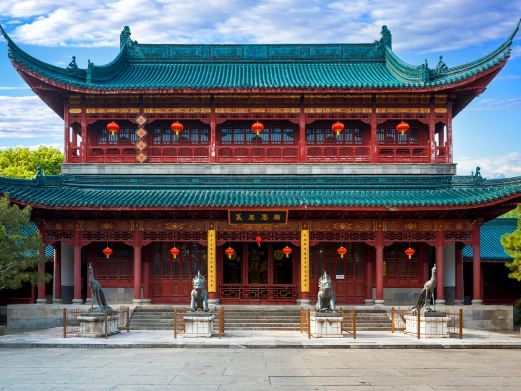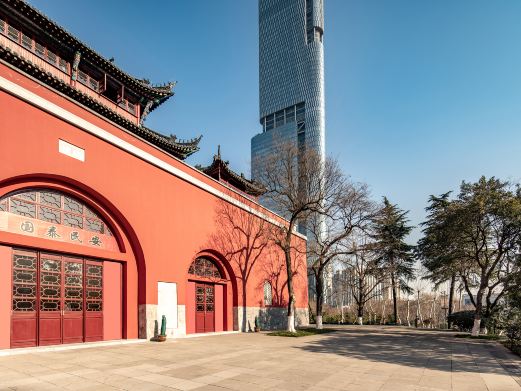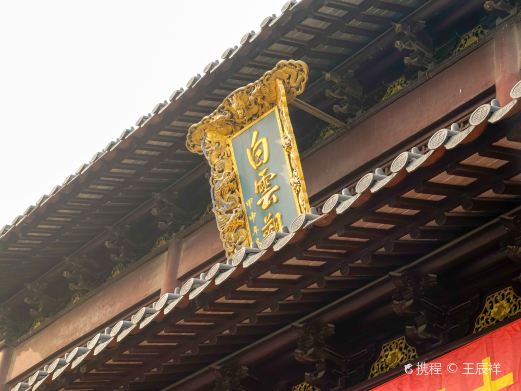Originally named Fushui Dong’an. It was built by monks and Taoists in 1371, the fourth year of Hongwu in the Ming Dynasty. During the Qianlong period, Chen Shihuang, a native of the county, added the Grand Compassion Hall and gradually took shape. However, in 1934, the entire temple was destroyed by fire. In recent years, it has been rebuilt by the Buddhist Association. The current mountain gate was originally the main gate of the Baoguo Courtyard and is the only remaining Ming Dynasty building.
During the renovation in the 1990s, it was changed into the mountain gate of Zanghai Temple, and the Zhenwu Hall of the Baoguo Courtyard was moved westward and rebuilt at its current location. The three characters ‘Zanghai Temple’ on the lintel were inscribed by Zhao Puchu, president of the China Buddhist Association. On both sides are couplets from Wang Wei’s ‘Qinglong Temple’ in the Tang Dynasty, handwritten by Yu Youren in his early years: ‘In the eyes of heaven and earth; In the Dharmakaya of the world’. The calligraphy is vigorous and resplendent. In the middle of the square inside the mountain gate, the ancient ginkgo tree soars into the sky, and incense in the tripod is continuous. The main hall of Zanghai Temple is now named ‘Puguangming Hall’, solemn and majestic. Zhao Puchu inscribed the plaque ‘Three Thousand Paths of Enlightenment’ for the main hall. The couplets were written by Qian Zhonglian. It says: ‘Since the establishment of the nunnery in Tianshui, how many kalpas have passed through stones? The Dharma sun shines again after a thousand years; When the Red Brightness opens the chronicle, the transformed city appears in an instant, and the Shu Peak flies in front of a lamp.’ The statue of Tathagata in Puguangming Hall has a solemn Dharmakaya. The guardians of the Dharma in the hall and the Thousand-Handed Avalokitesvara statue in the Grand Compassion Hall were all molded by the Ningbo Buddha Statue Research Institute in Zhejiang. The plaque of ‘Grand Compassion Hall’ on the east side of the hall was inscribed by Zhao Puchu. There is a plaque of ‘Tripitaka Dharma Wheel’ on the east side, inscribed by Xie Zhiliu. Inside the hall, there is a plaque of ‘Perform all good deeds’, inscribed by Qi Gong. Master Mingshan wrote couplets for this hall: ‘No self-image, no human image, no sentient being image, no longevity image; Have a compassionate heart, a kind heart, a joyful heart, and a great giving heart. ‘ To the east of the Grand Compassion Hall was originally the site of Fushui Dong’an. Now it is opened up as the East Garden, with lawns, pools, winding corridors, and flowers and trees, rising and falling irregularly and gracefully. The ‘Stele Inscription of the Ancestral Temple Returned to Monks for Management’ during the Qianlong period and the ‘Stele Inscription of Reconstructing Zanghai Temple’ in 1995 are respectively erected on the walls of the winding corridor. All the evolution of the temple, the rise and fall of successive dynasties, the reconstruction process, as well as landscape features, naming meanings, etc. are all briefly recorded. These two new and old cultural relics have become historical witnesses of the temple. Separated by a wall to the west of Zanghai Temple is the Baoguo Courtyard. Inside the courtyard is the Zhenwu Hall. There is also a courtyard and a hall door in front of the hall. In the middle of the hall, the statue of Zhenwu is enshrined and offered by believers. On the left and right are couplets written by Zhong Weng: ‘The spirit hall traces back to the Ming and Qing Dynasties. Virtue is spread in front of Yanxiang Hall. The common people look up to it; The cave heaven encompasses Wu and Yue. The wind returns to the shore of Shangfu Lake. The world is solemn.’ Opening hours: 8:00 – 18:00. Last admission: 16:00.Zanghai Temple
Originally named Fushui Dong’an. It was built by monks and Taoists in 1371, the fourth year of[...]









